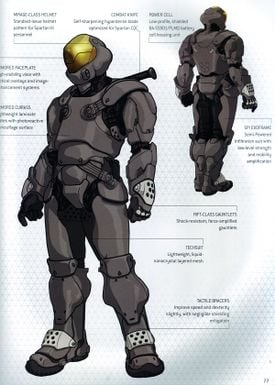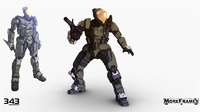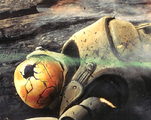Semi-Powered Infiltration armor
From Halopedia, the Halo wiki
| Semi-Powered Infiltration armor | |
|---|---|

| |
| Production overview | |
|
Manufacturer(s): |
|
|
Testing site(s): |
|
|
Role(s): |
Stealth/assault |
The Semi-Powered Infiltration armor (SPI armor) is a UNSC combat armor system designed with an emphasis on stealth through the use of special photoreactive panels.[2] The armor was developed by the Watershed Division, with Ruk Ariaustin as design lead.[1]
Overview
Described as "part legionnaire mail, part tactical body armor, and part chameleon", the SPI armor features photoreactive panels that mimic the surrounding textures, effectively being the UNSC equivalent to the Covenant's active camouflage systems.[3] The SPI armor features a full body armor with an enclosed helmet and heads-up display. The undersuit is equipped with a cushioning layer of liquid nanocrystal that provides more ballistic protection than three centimeters of Kevlar diamond weave, without the bulk.[4] The hardened armor plates, though advanced compared to standard UNSC infantry armor, can take only a few glancing blows before failing.[2]
Though more advanced than the Orbital Drop Shock Troopers' body armor, the SPI armor is less powerful than the Mjolnir armor originally issued to the Spartan-IIs.[5] Its main benefit is that it is drastically cheaper to produce than Mjolnir.[6] Although the SPI suit provides modest enhancements to the wearer's strength and mobility,[1] this amplification is not as drastic as that afforded by the Mjolnir.[7] Consequently, the SPI armor can be worn by any individual and does not require special neurological, skeletal or muscular augmentation; for example, the unaugmented instructors for the Spartan-IIIs often wore SPI armor.[8][9] The SPI armor is not as bulky or as heavy as the Mjolnir armor,[10] although the plating material is also less durable: Kelly-087 dented a Spartan-III's chest plate with her fist when first encountering the Spartan-IIIs.[11]
The SPI armor generally lacks an energy shielding system, making the user far more vulnerable to enemy fire. However, the Spartan-III Headhunters wore experimental armor that was equipped with energy shields due to their elite nature and value. However, power must be drawn from the energy shields to recharge the suit's active camouflage module.[12]
The baseline SPI armor can be easily destroyed from plasma based weaponry, armor piercing rounds and other threats. Overall the armor has inferior protection than Mjolnir armor, forcing the user to rely heavily on its stealth technology and superior tactics.[citation needed]
Operational history
Although early versions of the SPI system were tested by Orbital Drop Shock Troopers,[9] the armor was most prominently issued to the Spartan-III supersoldiers.[2] With over 2,000 units of SPI armor manufactured during the Human-Covenant War,[1] the SPI armor had been mostly phased out of use by Spartan-IIIs by 2558 in favor of Mjolnir. However, SPI continues to fill a usage niche in covert roles, particularly within ONI; the Spartan-IIIs in Veta Lopis' Ferret team often used SPI instead of Mjolnir due to the former's superior stealth capabilities.[13][14] The SPI armor has also been issued to non-Spartan personnel, such as Veta Lopis, whose suit was custom-built to fit her small frame.[15] SPARTAN-G059, deployed as an ONI assassin, used SPI as late as 2558.[16] As well, the photoreactive plating technology has seen limited but successful use in several special operations ODST units.[17]
Versions
Mark I
The Mark I was the first, experimental iteration of the SPI system used by the Spartan-IIIs of Alpha Company. The featured photoreactive panels gave the Spartans of Alpha Company a rough equivalent to active camouflage. The camouflage patterns, however, shifted irregularly and imperfectly, which made the photoreactive panels inferior compared to the Covenant's active camouflage technologies.[18]
Mark II
The Mark II was an improvement of the SPI Mark I, first used by the drill instructors of Beta Company, and then by the Spartans of Beta and Gamma Companies.[19] The armor sports new photoreactive coating to boost its camouflaging capabilities. Although the new photoreactive coating can mimic a wide range of electromagnetic radiation, it is still sensitive to overload, making the wearer vulnerable for several seconds after a flashbang or plasma shots from plasma weaponry or any directed energy weapon hit while the panels reset.[20]
The armor was proposed by Kurt Ambrose in 2537 for Alpha Company, but the request was denied because the armor was over budget.[21] After Alpha Company's Pyrrhic victory in Operation: PROMETHEUS, the Mark II was approved for mass production. After the augmentation of Gamma Company, small adjustments were installed into the Mark II SPI armor,[22] including experimental refits to the ballistic gel layers, upgraded software suites, and other functions, slated to be introduced to the systems prior to Gamma Company's deployment in 2552.[22] One major improvement is that the armor is now hermetically sealed and contains an internal oxygen supply for seven minutes.[23]
Mainline armor components
- MIRAGE-class helmet[24]
- The standard headgear of the SPI armor, the MIRAGE-class helmet features a large, bulbous faceplate somewhat similar to that of the Mjolnir EVA variant. The visor is normally gold-mirrored in color[25] and can be depolarized.[11] The helmet supports a heads-up display with features similar to that of the MJOLNIR system, including TACMAP, TEAMBIO, and TEAMCOM interfaces; a motion tracker;[26] as well as team status lights.[27][28] The visor suite features an automatic magnification and image enhancement system controlled by the wearer's eye movements. For example, if the wearer squints while looking at a particular spot the system will automatically zoom in.[29] Both the image enhancement and the visor's internal polarization can also be controlled manually.[30][31] The helmet possesses tactical lights[32] and a defogging vent to remove internal moisture.[33]
- Techsuit
- The bodysuit of the SPI system is composed of a layered mesh of ballistic liquid nanocrystal that is significantly more effective than traditional body armor materials such as Kevlar while being less bulky.[4][28][34] The techsuit's leggings[35] and sleeves can be removed independently.[36]
- Photoreactive panels
- The outer shell of the SPI armor comprises a series of lightweight laminate plates with a photoreactive coating.[1] The photoreactive panels act as active camouflage when active,[37] effectively blending the wearer with their environment.[2] The coating also renders the wearer nearly invisible to infrared and passive light-gathering systems.[38] Since the photoreactive plates take time to recover after explosions such as a flashbang grenade and plasma hits, the wearer is visible until the plates recover.[20] With the exception of the Headhunters' suits, the SPI armor does not feature energy field-based active camouflage systems like those of the Covenant.[12] When inert, the plating is matte gray[24][35] or green, though some SPI suits have been known to use different colors such as red.[39][40]
- Rift-class gauntlets
- The SPI suit is equipped with shock-resistant and force-amplifying Rift-class gauntlets.[1]
- Tactile bracers
- The bracer armor pieces around the boots grant slight improvements to speed and dexterity with negligible shielding reduction.[1]
- Environmental controls
- The suit possesses rudimentary environmental regulation system to maintain a comfortable temperature for the wearer.[41] However, the system is not designed for extended use and it will become increasingly uncomfortable to wear if used continuously over long periods of time.[42] As of 2552, the Mark II SPI armor is also fully sealed and contains an internal oxygen supply.[23] The armor also has an efficient cooling system and is significantly difficult to detect even with thermal scanners.[19]
- Biofoam injection ports
- Like MJOLNIR, the SPI armor has dedicated ports allowing the quick injection of biofoam or other battlefield pharmaceuticals.[43]
- Data socket
- The SPI armor's gauntlet features a data port to which small electronic devices such as data pads can be connected.[44][45]
- Power cell
- The armor is powered by a low-profile, shielded BA-55901/PLMD battery cell.[24]
Variants
In addition to the standard model, several variants of the SPI armor exist.[Note 1]
Air Assault-like
This variant has a Stalker-like suit, with a helmet that is similar in design to Air Assault. It was utilized by Roland-B210. It was equipped with Motion trackers, energy shielding, VISR technology and a prototype active camouflage.
Pilot-like
This variant has a helmet design that is similar to Pilot. A Spartan-III wearing this variant was stuck in Onyx between 2552 and 2553.
Grenadier-like
This variant has a helmet design that is similar to Grenadier. Mark-G313 wore this suit during Operation: JOVIAN WHISTLE.[Note 2]
Mirage
- Main article: MIRAGE-class Mjolnir
This variant is a modified SPI armor and compatible with the MJOLNIR Powered Assault Armor Mark VI. It incorporates the latest in software-definable deception jammers, and the forearms are a further refinement of the RIFT-class force-amplification gauntlets found on the standard SPI armor.
Production note

|
Browse more images in this article's gallery page. |
The SPI armor is referred to as "PR" twice in Halo: Ghosts of Onyx.[46][47] No context or explanation is provided for this alternate designation, although it is possible that the suit was known as "PR" (possibly an acronym for "PhotoReactive") in an earlier revision of the novel's manuscript and that the presence of the two mentions in the final book is an editing oversight.
Gallery
A Spartan-II clad in MIRAGE-class Mjolnir in the Halo 3 portion of Halo: The Master Chief Collection.
Two Headhunters, Roland-B210 and Jonah-B283, wearing SPI armor. The former is wearing an unknown variant.
An energy shielded SPI suit's HUD. Note the HUD's resemblance to that of the MJOLNIR Mark V.
Jonah-B283 wearing his SPI armor.
Olivia-G291 in SPI armor with her helmet removed.
SPARTAN-G059 clad in SPI armor.
Veta Lopis equipped with SPI armor.
List of appearances
- Halo: Ghosts of Onyx (First appearance)
- Halo 3 (Halo: The Master Chief Collection only)
- Halo: Evolutions
- Halo: Reach (Mentioned only)
- Halo: Glasslands
- Halo: Last Light
- Halo Mythos
- Halo: Tales from Slipspace
- Halo: Retribution
- Halo: Official Spartan Field Manual
- Halo: Divine Wind (Mentioned only)
Notes
- ^ Similar to the somewhat differing depictions of Mjolnir armor, the exact design details of the "default" SPI armor vary between different sources of Halo canon, sometimes within a single source. Since it is difficult to determine which of these examples constitute officially-defined variants of the suit rather than artistic license, only the versions that overtly deviate from the standard pattern are listed below, while the gallery section provides examples of less pronounced variety between SPI suits.
- ^ In the cover of Halo: Last Light, Mark (who is seen in the background of the image) is depicted as wearing a standard set of SPI armor.
Sources
- ^ a b c d e f g h Halo Mythos, pages 76-77
- ^ a b c d Halo: Ghosts of Onyx, page 14
- ^ Halo: Ghosts of Onyx, page 16
- ^ a b Halo: Ghosts of Onyx, page 171
- ^ Halo: Glasslands, page 207
- ^ Halo: Ghosts of Onyx, page 46
- ^ Halo: Last Light, page 33 (Google Play edition)
- ^ Halo: Ghosts of Onyx, pages 89, 94
- ^ a b Halo: Ghosts of Onyx, page 164
- ^ Halo: Glasslands, page 40
- ^ a b Halo: Ghosts of Onyx, pages 168-169
- ^ a b Halo: Evolutions - Essential Tales of the Halo Universe, "Headhunters", page 212
- ^ Halo: Retribution, Chapter 18
- ^ Twitter: Troy Denning status update #912699859924393984
- ^ Twitter: Troy Denning status update #879779858393440256
- ^ Halo: Tales from Slipspace, Knight Takes Bishop
- ^ Halo Waypoint - Cannon Fodder: Fifty Caliber
- ^ Halo: Ghosts of Onyx, page 85
- ^ a b Halo: Ghosts of Onyx, page 89
- ^ a b Halo: Ghosts of Onyx, page 113
- ^ Halo: Ghosts of Onyx, page 80
- ^ a b Halo: Ghosts of Onyx, page 99
- ^ a b Halo: Ghosts of Onyx, page 251
- ^ a b c Halo Mythos, page 77
- ^ Halo: Ghosts of Onyx, page 115
- ^ Halo: Last Light, page 146 (Google Play edition)
- ^ Halo: Ghosts of Onyx, pages 17, 22
- ^ a b Halo: Ghosts of Onyx, page 114
- ^ Halo: Ghosts of Onyx, page 19
- ^ Halo: Ghosts of Onyx, page 268
- ^ Halo: Ghosts of Onyx, page 345
- ^ Halo: Ghosts of Onyx, page 273
- ^ Halo: Ghosts of Onyx, page 316
- ^ Halo: Ghosts of Onyx, page 360
- ^ a b Halo: Ghosts of Onyx, page 141
- ^ Halo: Last Light, page 125 (Google Play edition)
- ^ Halo: Ghosts of Onyx, page 165
- ^ Halo: Last Light, page 95 (Google Play edition)
- ^ Headhunters motion comic
- ^ Halo Mythos, page 135
- ^ Halo: Ghosts of Onyx, page 22
- ^ Halo: Ghosts of Onyx, page 254
- ^ Halo: Ghosts of Onyx, page 362
- ^ Halo: Ghosts of Onyx, page 310
- ^ Halo: Ghosts of Onyx, page 356
- ^ Halo: Ghosts of Onyx, page 87 ("...the flaws in their Mark-I PR suits...")
- ^ Halo: Ghosts of Onyx, page 141 ("...and pulled on the PR leggings.")
| ||||||||||||||||||||

















